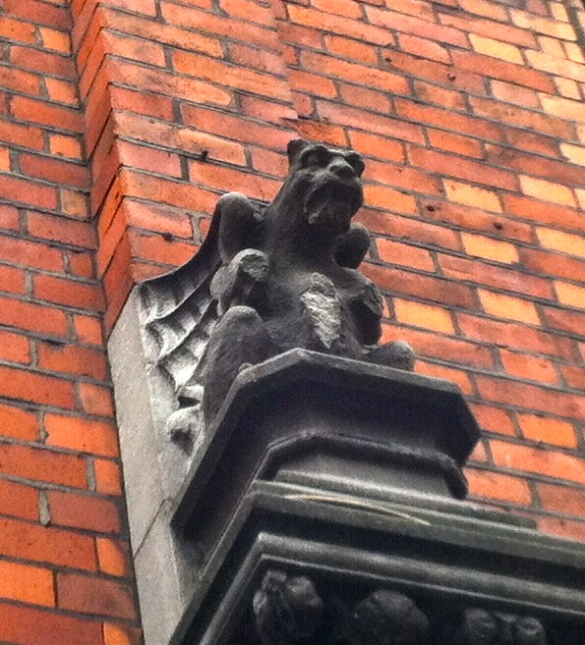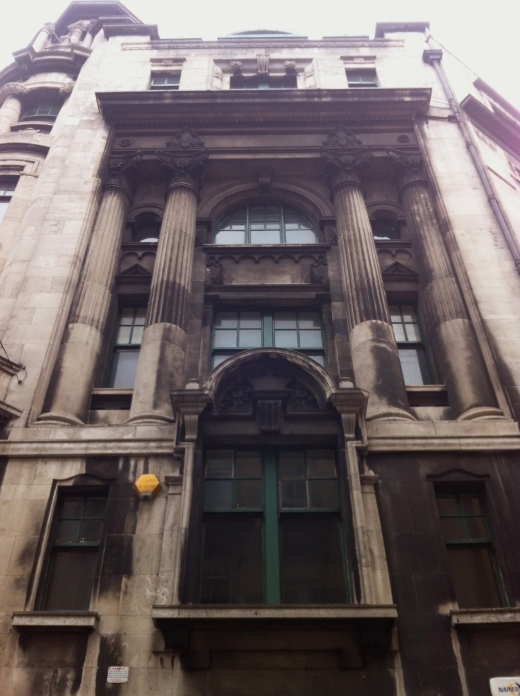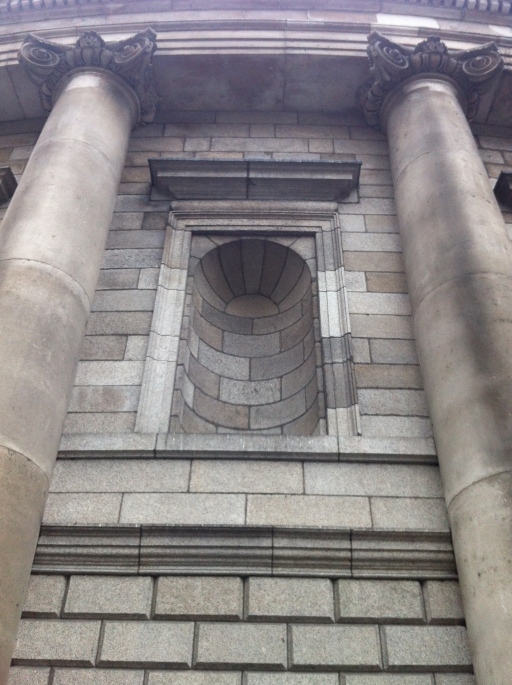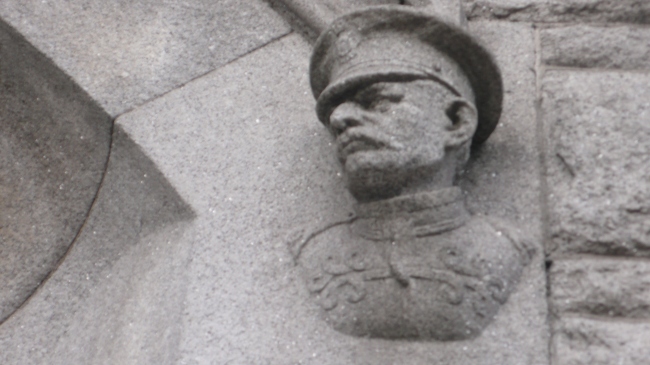Some snaps and details from a recent walking tour (April 13th) with architectural historian & expert in 18th Century Dublin shops, Sarah Foster. Unfortunately the day was a cold and grey, so forgive the dull light. Some of these details (like the gargoyle above) Sarah pointed out, in a few other cases I wandered off the route to snap things that just caught my eye. These pictures are in no particular order, they do not reflect the route of the tour, a tour short in distance but fascinating on history & detail. It took place, incidentally, right in the centre, from the steps of Royal Exchange, (figure 2, below)
Then we crossed Dame St to Parliament St., just across the road, to view the oldest, surviving shop in Dublin: Thomas Read & Co; Cutlers. (below)
This wonderful old place is sadly closed these last 13+ years or more, and part of the old premises were turned into a pub. Yet the main old shop interior, with its Chippendale style cabinet work and outfitting are all still mercifully intact, (albeit currently inaccessible)
I hope to post about the tour in more detail soon. In the meanwhile, enjoy the pictures.
From outsides’ old Reads shop we simply went down Dame Street, were we saw this nice gargoyle- if “nice” is a word one is allowed use about Gargoyles, (Nice is probably a grievous insult, in gargoyle world, where being scary and menacing is all the rage)
Anyway.. here’s another plaque (see below). Look carefully, see the ship? There is an extraordinary story, or stories in fact, behind the ship in this plaque, but that’s for another day.
Dame Street alas, is increasingly disfigured with plastic signs, junk food, and tourist shops, (& usually clogged with busses & heavy traffic)
Did you know all the exteriors on Dame Street, and indeed on Westmoreland St and D’Olier St, used to look like this? (below)
This is one, the only small surviving section (this is on D’Olier st) But Dame Street used to look just the same, every single of of the shop fronts, on every building, was one of these lovely classical granite facades. Unfortuneately, nearly every one of them has now gone. As far as we know, there’s just one, solitary survivor left on Dame Street. Has it been honoured, lovingly tended, treasured and revered? Of course not! This is Dublin. (Have a look below) Sadly, this is what it looks like today.
Lovely, eh?
let’s just have one more look again at the alternative, (below again) by way of comparison. Admittedly this was an office building, not shops. It used to be the premises of the Irish Times (newspaper) who had the resources and the wit to pay for the restoration. They’ve now moved to nearby Tara St, but they did Dublin a signal service.
All the heavy traffic & plastic tat in the modern city centre, is pretty grubby & depressing. It is especially bad on Westmoreland St, and Dame St is not much better. We should have strict laws about the type of signage traders are allowed use, and what materials, much as they have in the historic areas of many French & Italian cities. There’s no doubt a few strong laws here would restore much of the lost, almost invisible beauty of Dublin, now currently chocking under a sea of plastic tat, visual clutter, and busy chaotic streets, chocked in traffic fumes. A better traffic system, and few good laws could help redeem the situation in just a few short years. Will this ever happen? Perhaps. But don’t hold your breath.
Yet, even now, despite so much destruction, amid the traffic & plastic tat on Dame St, on those occasions when one can look upwards, the street is still full of wonderful architecture, decor & detailing.
We went down Dame St, as it changes into College Green, in front of the gates of Trinity College. then around the corner of the enormous old Parliament Building here, (detail from Parliament Building below)
We were now onto Westmoreland St. I was totally unaware that Henry Aron Baker (collaborator on the Kings Inns with, pupil of, and de facto successor to, the great James Gandon) was once commissioned by the Bank Of Ireland to build an enormous bank headquarters on this spot, occupying, it’s believed, the entire triangle.
This would have been truly spectacular, in both size and style. But it was not to be. In 1801, the Act of Union meant the Irish Parliament vacated their home on College Green and moved to London, at which point the Bank of Ireland moved into the old (and magnificent) Parliament building. In the end, the plots on the east side of Westmoreland St were developed in smaller, separate lots.
Nonetheless, there are many fine buildings here. As Sarah pointed out, this was the headquarters of many of Dublin’s insurance firms. Much like the many bank headquarters around the corner back on Dame Street, such clients tend to invest in high quality, prestige design. So many of the buildings here, above ghastly street level, are of very high quality. Since many of the insurance firms hailed from Edinburgh or Glasgow, there is a noticeable preference for the Victorian Revival style, notably in the Scottish Baronial idiom!
Where Westmoreland St meets the edge of O’Connell’s St. Bridge (southside) we hair-pinned around and went back up the other side of the triangle, up D’Olier St. This is where Sarah pointed out the last of those beautiful remaining granite facades discussed earlier. We also had another look at the back of the marvelous old Gas Company Headquarters (below)
Yes, it’s all completely bogus and pastiche of course, Victorian Revival Tudor (very rare in Dublin, but if you know Liberties shop in London….) but very good of its kind. As Dubliners know, the front of this building, on Westmoreland St, is completely different in style, a very cool Art Deco classic. (See just below)
Since this type of Art Deco is also pretty rare in Dublin, I reckon that’s a double score for the gas company) Here, back once again on the mock Tudor side is a 1820s plaque from the old Gas firm, (below)
We also took a good look at the amazingly richly decoration of the old D’Olier Chambers, that occupies the last plot on the street. (detail below)
We finished near old Screen cinema, by Pearse St. Gardaí station. (that’s our Irish police for overseas readers) This building goes back to the old days of the Royal Irish Constabulary and the Dublin Metropolitan Police. Unable to resist here showing you one last pair of decoration, familiar to all Dubliners, the terrific carved policemen’s heads from the exterior of the police station.
That’s it for now. Hope you all enjoyed. Comments & observations welcome as always. Thank you for reading. – Arran.


















Thanks Arran, always look forward to your pictorial wanderings.
LikeLike
aww, many thanks to you Valerie, very very kind. 🙂
LikeLike
The Gas Company Headquarters are really beautiful. How different (back and front of the house)!
Quite interesting to walk along with you!
-Michèle
LikeLike
hi Michéle, yes the contrast is bizarre i agree. They – the front and back- could hardly be more different, and were clearly built over 100 years apart. It would be interesting to find a shot of the original, old front facade, on Westmoreland St. Presumably it was in the same, Tudor-revival, style as the rear elevation. Or was it? One never knows. I must chase that down sometime soon. Or, who knows? Are any of our readers in a position to advise?
LikeLike
Love gargoyles! your shots are great
LikeLike
The D’olier Chambers is impressive.
Oh, totally forgot to share! I seen this building the other day and thought of you: http://theawkwardpose.files.wordpress.com/2011/08/110812-boseman-front1.jpg
One side said 1924 and the other 1800-something. It looks the same all the way around so didn’t quite understand the different dates. Wish we’d gotten some photos of it!
LikeLike
Here’s a little more info about it: http://gohistoric.com/sites/bozeman-waters-national-bank-poseyville
LikeLike
That’s interesting and unusual, (the different dates), front & back, or even on two facades on same side) ) but of course it can happen. If one facade is designed and constructed, say finished in 1897 or something, and the other rebuilt, or re-faced, or what have you 30 years later, it can happen. Confusing though. 🙂 Thanks for the pictures and the info. Looks a great, great building by the way, I love it. Really amazingly elaborate, richly detailed and decorated carving, for what appears to be a fairly normal size 2-story building. I always love that type of contradiction. You know, your picture, and that whole general train of thought jogged a memory, I now I recall a really small building inn the north residential part of Oxford, the Jericho district I think. It was tiny, (much, much smaller than your bank (which i appreciate extends well to the right of picture) but anyway this was tiny. Yet it somehow had an amazingly grandiose Baroque style archway!. Then somebody had filed that in with glass, and now (or at least 20 years ago when i was there) it was serving, if I remember right as a little laundry business! I can not find any trace of it now, on the net, and suspect my own memory. Wish I had taken pictures at the time. Hope to God its still there, in whatever present incarnation. Love your bank building though, really super. Appears to be a sort of heavy, ornate, Spanish Baroque in decor, but did they get to Indiana? Or is it pastiche, or revival, do you think? (there was a very high quality revival of this style, in 19th century Florida for example.) Anyway, I love it. many thanks JG.
LikeLike
That really sounds like something. If you ever luck out and find any photos of it online, I’d love to see it!
Here’s a photo of the side: http://upload.wikimedia.org/wikipedia/commons/0/03/Bozeman-Waters_National_Bank%2C_front_and_western_side.jpg
The dates can be made out it is 1884. I located a book on Google Books of the history of Posey Co. and apparently Bozeman & Waters National Bank (as you can see from the photo the building now houses Fifth-Third Bank but the building is still referred to as Bozeman-Waters) was founded in 1884. So I suppose that’s the reason for the 1884. As for the architectural style, I’m not sure being unfamiliar with the subject. Some websites just say American Movement or Sullivanesque. You’ve got me curious now!
LikeLike
Well, it’s a fascinating subject, “Sullivanesque” of course refers to the great Louis Sullivan, father of modern and American architecture & one of the fathers of modern architecture globally, and especially of the skyscraper, but of course I’ sure you know all that. It was he of course who coined the famous phrase “Form follows function” an axiom of modernism, although if you look close at his buildings they are actually covered in lovely detail & ornament! (eg the Wainwright building, or the entrance to the (old) chicago stock exchange building.) There is another amazing american character i came across recently, who wanted to totally redesign Washington DC, I’ve written a draft blog about him and his plans, which I hope to publish on in late-May or sometime june. America is full of these amazing people. Oh, and finally, I did have a good look for that funny little Oxford building in Google, but absolutely no luck. If I ever find something I’ll be sure to drop you a line. Many thanks JG, great to hear from you. -Arran.
LikeLike
Wonderful walking tour!
LikeLike
Thank you Naomi, very kind. 🙂
LikeLike
You know, gargoyles have feelings too. Maybe they’d enjoy being referred to as “nice” every so often. That Gas building facade is wild–it looks like something that one would easily find in NYC, so surprising to see it in Dublin. The facades on Dame Street and D’Olier Street must have been quite impressive back in the day, with all those lovely classical facades. There’s a patch in Manhattan that I grieve over, it was once a full block of Greek Revival houses complete with columns. The bits that are left are so shabby looking and I’m surprised they haven’t been taken over by neon.
LikeLike
That’s wild. Where is that patch of Manhattan? Did you really have that same style of Greek-revival type-idiom there in NYC? It’s rare enough world-wide but I always love it, far more minimal, stylish, hard & austere than Roman variety classical. The Romans, far too lush & bling in my view; too interested in money and power, not as smart as the brilliant Greek, with all their ideas and gifts of the mind. Also, (news just in) -my apologies to all Gargoyles who may be reading. But I suspect they relish their reputation, for general leering and fierce, sinister looks.
LikeLike
It’s in Soho, around the NYU area. Heartbreaking to see the sad remnants now. Behold:
Before: http://fearnoweebles.files.wordpress.com/2013/05/before.jpg
And now: http://fearnoweebles.files.wordpress.com/2013/05/after.jpg
The buildings are called Colonnade Row, built in 1833. They were, and are, among the very few Greek Revival buildings in the city. I can only imagine how stunning they must have looked in their prime.
LikeLike
Just had a look at your two photo-links again. Thank you for sending. Stunning buildings but as you say, also criminal so many have been destroyed (and the others festooned in tat). Could not agree more, heartbreaking is the word. Want to get back to NYC one day, will prowl around Soho area and see if I can spot. Delighted you enjoyed the Albi piece, have added small extra note on stone carving bit. Respects as always M. Weebles.
LikeLike
Hi Arran
Sarah Foster here, just came across your site when looking for some dates for Dublin shop keepers – and it was lovely to see that I had stumbled across a record, and some images from the tour last year.
Pleased to see how much you enjoyed it (and how much you took in, on that very chilly day!)
every good wish – Sarah
LikeLike
Hi Sarah, I’m absolutely delighted you stumbled across this post, which is obviously an account of your own wonderful tour last year. Yes, i loved it, packed with fantastic detail and analysis. I got and learned a huge amount from that tour, thank you so much, both for the tour itself, and indeed for your kind comments above.
my very best regards and respects- Arran.
LikeLike
I accidentally found the site …many thanks …Your last photos show the Dublin Metropolitan police heads on Pearse Street Garda station …I believe my Grandfather carved these heads ..Henry Thompson is his name and he is best remembered for his work on Mullingar cathedral
Thanks
Harry Thompson
LikeLike
That is great and fascinating information to receive Henry. I shall most certainly mention your grandfather to my guests on future walks in this area. Excellent work, – I’ve always been a big fan of the heads, they convey a very reassuring solidity, most apt for a police station. Delighted you found the blog, delighted you enjoyed the piece above. Many thanks for your comment and kind words.
-Arran.
LikeLike